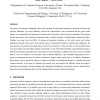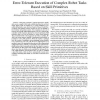208 search results - page 25 / 42 » How can a robot have consciousness |
IROS
2008
IEEE
14 years 1 months ago
2008
IEEE
— Legged robots require accurate models of their environment in order to plan and execute paths. We present a probabilistic technique based on Gaussian processes that allows terr...
AR
2006
13 years 7 months ago
2006
The development and expression of many higher level cognitive functions, such as imitation, spatial perception, and tool-use relies on a multi-modal representation of the body kno...
EPIA
2005
Springer
14 years 1 months ago
2005
Springer
In this paper, we look at the Multi-Agent Meeting Scheduling problem where distributed agents negotiate meeting times on behalf of their users. While many negotiation approaches ha...
ISCI
2002
2002
Intelligent learning and control of autonomous robotic agents operating in unstructured environments
13 years 7 months ago
The control of autonomous intelligent robotic agent operating in unstructured changing environments includes many objective difficulties. One major difficulty concerns the charact...
ICRA
2003
IEEE
14 years 25 days ago
2003
IEEE
— This paper presents a general approach to specify and execute complex robot tasks considering uncertain environments. Robot tasks are defined by a precise definition of socal...


